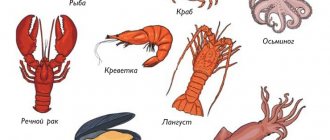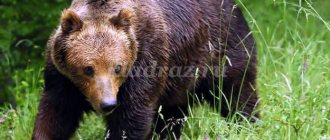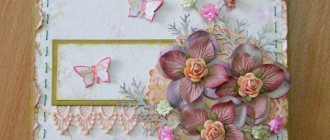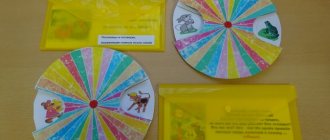Didactic games to familiarize children 2-3 years old with the world around them
Exploring the natural world
Find the same leaf
Introduce your child to the concept of “leaf fall.”
Collect fallen leaves. Together with your baby, inhale this unique smell of autumn foliage, hold the leaves up to the light, and admire their color and vein pattern. Place birch and maple leaves in front of your baby and draw his attention to their differences in color, size and shape. Then, show your child, for example, a maple leaf and ask him to find the same one. Then try to find the tree from which that leaf fell.
Sort the leaves
Take an armful of leaves and place them on a bench. Then invite the baby to arrange all the leaves into two piles according to some specific characteristic: large and small leaves; yellow and red; birch and maple.
What does it look like?
When collecting natural material, determine what is similar to what. For example, a cone - for a hedgehog, an acorn cap - for a real cap, ash and maple wings - for flower petals, etc. When you return home, you can make appropriate crafts.
Autumn wreath
Show your child how to weave a wreath from autumn leaves. Take a photo of your child wearing this fall wreath.
Birds and animals
Prepare figurines of various animals or cards with their images. Look at the animals with your child and highlight their common characteristics (they have a head, ears, nose, body, paws, tail, their bodies are covered with fur). In the same way, look at and comment on the images of birds (they have a head, a beak, no ears or nose, their bodies are covered with feathers). Then invite your child to distribute all the cards into two groups: birds and animals.
Domestic and wild animals
Draw a house and a forest. Prepare cards with images of domestic animals and inhabitants of our forests. Invite your child to classify the animals into those that live near people and those that can only be found in the forest.
Who's flying?
You show your child object pictures depicting various animals. If this animal flies (crow, dragonfly, etc.) - the child waves his arms as if he is flying. If the animal cannot fly, the child does nothing or claps his hands. You can also depict who can swim (crocodile, duck, fish) or who can jump (grasshopper, frog, cat).
Third wheel
You can offer your child the game “third wheel”. Place three cards in front of him: two mushrooms and one apple. Ask what is unnecessary here. At first, the “extra” item should be significantly different from the other two (two potatoes and a penguin, two oranges and a pine cone), a little later the difference should be less pronounced (two apples and a pear, two porcini mushrooms and a russula).
What's in the basket?
Place vegetables and fruits in the basket (1-2 pieces of each type). Let the child take them out of the basket one at a time and name them. You can also put it in two bowls - vegetables and fruits. Or draw a tree and a bed on cardboard and lay the fruits on them. Or an even more interesting task is to “cook” compote and soup: put fruits in a jar and vegetables in a pan. Exploring the world of objects
What's in the box?
The box contains various items (a button, a comb, a felt-tip pen, a book, etc.). The child takes them out in turn, names them and says why they are needed.
Transport
Take one car out of the box at a time: car, truck, bus. Examine and note the material from which each machine is made, its color, purpose, etc. Highlight their common features (all cars have wheels, a steering wheel, a cabin) and their differences.
Dishes
Draw a cabinet with shelves on a piece of paper with a pencil. Say that now you need to fill the cupboard with dishes. Let the child tell you what to draw, and you will “arrange”: a cup, a pan, a teapot, etc.
Select items
Various items are laid out on the table. Invite your child to choose only those items that will help him wash himself in the morning (soap, towel, toothbrush, toothpaste) or items that are necessary for food (plate, spoon, fork).
Clothes and shoes
Select subject pictures with images of clothing, or you can use illustrations from books. Based on the pictures, discuss with your child what clothes and shoes should be worn when it is cold or, conversely, hot outside.
Dressing up the doll
Take the doll. Invite your child to go for a walk with her, but first he will have to choose clothes for her according to the weather (if it’s winter now, then you need to dress her in a warm fur coat, hat, boots).
Looking at story pictures
In order to study the environment, plot pictures are very suitable, where, for example, the furnishings of a room are depicted - then you can discuss with your child what a table, a chair is needed for, what is put away on shelves and what is stored in a closet, etc. Introduction to work
Wash
Pour water into a basin for your child, fill it with foam and offer to wash handkerchiefs or doll clothes. And then rinse the laundry in a bowl of clean water. And of course, a special pleasure for the child is to hang it all up to dry on a line, securing it with clothespins.
Washing dishes
Sometimes doll dishes also need to be washed. Prepare two basins: one with soapy water, the second with clean water. Show your child how to first wash dishes in the first basin with a sponge, and then rinse them in the second and dry them with a towel.
Conversations based on pictures
With your child, look at story pictures that depict people’s work: “A bus driver is carrying children,” “A doctor is treating a boy,” “A gardener is planting trees,” etc. Discuss what is drawn: who is shown in the picture, what each of them is doing, what would happen if there were no doctors, teachers, educators, etc.
Author: Koldina Daria
Intellectual development
At this age, visual-effective thinking is transformed into visual-figurative thinking. If previously the baby learned about the world through direct contact with various objects, now he can already operate with images of these objects stored in his memory.
At three years old, a child should be able to:
- understand simple cause-and-effect relationships;
- demonstrate first action planning skills;
- compare objects by size, shape, color;
- put together simple puzzles from four large parts;
- know the basic colors and be able to name them;
- know the names of surrounding objects (dishes, furniture, products), animals;
- know the names of basic geometric shapes.
An important feature of this age is that a growing baby can think and reason about objects that are not in the field of view. This is an important step towards further development of thinking.
Neuropsychic development
During this period, the performance of the nervous system increases. The baby can already restrain his emotions, for example, not cry when he is hurt or offended.
His ability to concentrate increases. Now he can do something for 10–15 minutes without being distracted by anything else. Distracting a crying three-year-old by redirecting his attention is not so easy, because he has already concentrated on his negative emotions.
At this age, the child cannot yet properly manage his behavior. The three-year crisis mentioned above also adds to the difficulties. The baby's inner world is full of contradictions that result in whims and hysterics.
Physical development
A 3-year-old child controls his body much more confidently than a 2-year-old. At this age, children can:
- jump on two legs in height and length;
- stand on one leg without falling;
- jump over obstacles;
- run quickly and confidently;
- climb the wall bars;
- ride a tricycle or scooter;
- ride downhill;
- kick the ball.
Kids love physical activity and quickly develop their abilities.
Speech development
The speech of a three-year-old is very different from the speech of a two-year-old baby. At this age, the child already has a fairly large vocabulary - from 1000 words. The baby can reason and make simple conclusions about people, objects and phenomena.
Children actively remember new words, play with them (change pronunciation, rhyme, come up with sound combinations). Long, complex words are still difficult for babies to pronounce, so they mutilate them.
A 3 year old child should be able to:
- tell how his day went;
- use sentences of 3–5 words or more in speech;
- describe the picture;
- memorize poems and songs;
- name not only the object itself, but also its details (handle of a cup, nose of a dog);
- establish semantic connections between objects;
- ask and answer questions;
- Use polite words (“thank you”, “please”).
Three-year-olds do not yet have very well developed speech. They pronounce hissing and sonorant sounds poorly. They construct sentences incorrectly and lose the endings of words. All this is the norm of development. With age, problems will be eliminated.
Logical thinking
At 3 years old, children already have some logical thinking skills. They must be able to:
- combine two objects into a logical pair (“pencil-paper”, “tea-cup”);
- exclude unnecessary items from a group;
- understand the logical sequence of events (clouds gathered in the sky - it began to rain - the ground became wet);
- highlight the main properties of objects and combine them into groups according to these properties;
- understand time sequence (“yesterday”, “today”, “tomorrow”, “now”, “later”);
- distinguish opposites (big - small);
- understand the location of objects in space (“above”, “below”, “above”, “below”).
Fine motor skills
The youngest preschooler actively develops and improves fine motor skills. He must be able to:
- hold a pencil, felt-tip pen, or drawing brush correctly;
- trace simple drawings using dots;
- draw geometric shapes, straight and broken lines;
- write familiar block letters;
- use scissors to cut simple shapes from paper;
- shade the drawing in different directions;
- coat the paper appliqué parts with glue and glue;
- sculpt balls and sausages from plasticine and connect them.
There are many finger games for developing a child's fine motor skills.
Math skills
At 3 years old, children already have some mathematical skills. They must know and be able to:
- count to five forward and backward;
- show the number on your fingers;
- know what numbers from 1 to 5 look like;
- compare the number of objects in different groups using the concepts “more”, “less”, “same”;
- know and be able to draw basic geometric shapes (circle, square, triangle, oval, rectangle);
- recognize the outlines of geometric shapes in various objects (a clock is a circle, a TV is a rectangle).
Some kids already know all the numbers from 0 to 10 and can write them. This is a good help for future preparation for school.
Self-care skills
Children at 3 years old can already do a lot on their own, without the help of their elders. For example:
- dress, undress, fasten and unfasten zippers and large buttons;
- putting on shoes (it’s normal if the baby puts shoes on the wrong foot);
- confidently wield a spoon and fork, drink from a cup, wipe your mouth with a napkin;
- wash your face, wash your hands, brush your teeth;
- put toys back in place;
- carry out small household tasks (lay out cutlery on the table, pour food into the cat’s bowl).
The less parents try to help the baby, the faster he develops everyday skills.
Development of attention
Three-year-olds must have the following skills:
- concentrate on the task at hand for 10–15 minutes;
- keep up to five objects in your field of vision at the same time;
- remember and repeat after an adult the suggested words and movements.
It is worth remembering that the attention of a junior schoolchild is still unstable and easily scattered.



